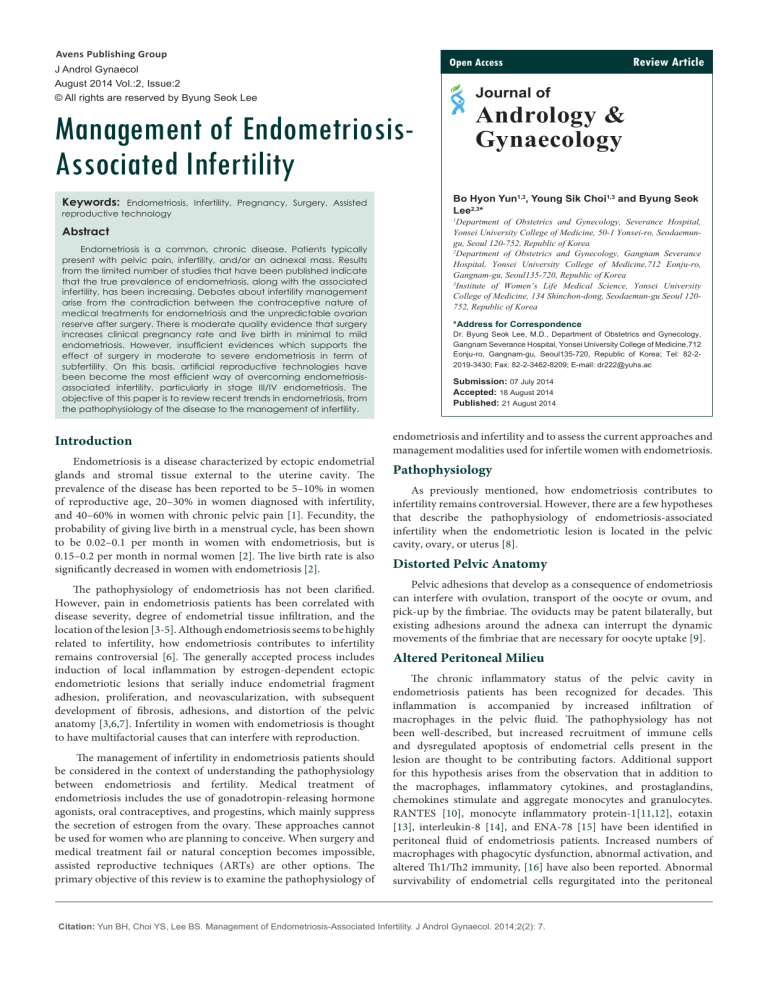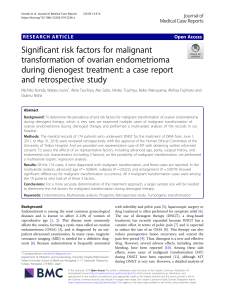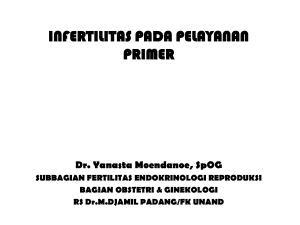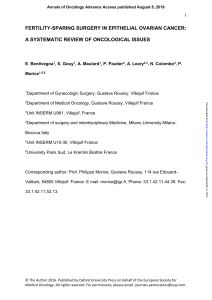Uploaded by
common.user22013
Management of Endometriosis-Associated Infertility: A Review
advertisement

Avens Publishing Group Open Access Invi t ing Innova t ions J Androl Gynaecol August 2014 Vol.:2, Issue:2 © All rights are reserved by Byung Seok Lee Journal of Group Avens Publishing Invi t ing Innova t ions Andrology & Gynaecology Management of EndometriosisAssociated Infertility Keywords: Endometriosis, Infertility, Pregnancy, Surgery, Assisted reproductive technology Abstract Endometriosis is a common, chronic disease. Patients typically present with pelvic pain, infertility, and/or an adnexal mass. Results from the limited number of studies that have been published indicate that the true prevalence of endometriosis, along with the associated infertility, has been increasing. Debates about infertility management arise from the contradiction between the contraceptive nature of medical treatments for endometriosis and the unpredictable ovarian reserve after surgery. There is moderate quality evidence that surgery increases clinical pregnancy rate and live birth in minimal to mild endometriosis. However, insufficient evidences which supports the effect of surgery in moderate to severe endometriosis in term of subfertility. On this basis, artificial reproductive technologies have been become the most efficient way of overcoming endometriosisassociated infertility, particularly in stage III/IV endometriosis. The objective of this paper is to review recent trends in endometriosis, from the pathophysiology of the disease to the management of infertility. Introduction Endometriosis is a disease characterized by ectopic endometrial glands and stromal tissue external to the uterine cavity. The prevalence of the disease has been reported to be 5–10% in women of reproductive age, 20–30% in women diagnosed with infertility, and 40–60% in women with chronic pelvic pain [1]. Fecundity, the probability of giving live birth in a menstrual cycle, has been shown to be 0.02–0.1 per month in women with endometriosis, but is 0.15–0.2 per month in normal women [2]. The live birth rate is also significantly decreased in women with endometriosis [2]. The pathophysiology of endometriosis has not been clarified. However, pain in endometriosis patients has been correlated with disease severity, degree of endometrial tissue infiltration, and the location of the lesion [3-5]. Although endometriosis seems to be highly related to infertility, how endometriosis contributes to infertility remains controversial [6]. The generally accepted process includes induction of local inflammation by estrogen-dependent ectopic endometriotic lesions that serially induce endometrial fragment adhesion, proliferation, and neovascularization, with subsequent development of fibrosis, adhesions, and distortion of the pelvic anatomy [3,6,7]. Infertility in women with endometriosis is thought to have multifactorial causes that can interfere with reproduction. The management of infertility in endometriosis patients should be considered in the context of understanding the pathophysiology between endometriosis and fertility. Medical treatment of endometriosis includes the use of gonadotropin-releasing hormone agonists, oral contraceptives, and progestins, which mainly suppress the secretion of estrogen from the ovary. These approaches cannot be used for women who are planning to conceive. When surgery and medical treatment fail or natural conception becomes impossible, assisted reproductive techniques (ARTs) are other options. The primary objective of this review is to examine the pathophysiology of Review Article Bo Hyon Yun1,3, Young Sik Choi1,3 and Byung Seok Lee2,3* 1 Department of Obstetrics and Gynecology, Severance Hospital, Yonsei University College of Medicine, 50-1 Yonsei-ro, Seodaemungu, Seoul 120-752, Republic of Korea 2 Department of Obstetrics and Gynecology, Gangnam Severance Hospital, Yonsei University College of Medicine,712 Eonju-ro, Gangnam-gu, Seoul135-720, Republic of Korea 3 Institute of Women’s Life Medical Science, Yonsei University College of Medicine, 134 Shinchon-dong, Seodaemun-gu Seoul 120752, Republic of Korea *Address for Correspondence Dr. Byung Seok Lee, M.D., Department of Obstetrics and Gynecology, Gangnam Severance Hospital, Yonsei University College of Medicine,712 Eonju-ro, Gangnam-gu, Seoul135-720, Republic of Korea; Tel: 82-22019-3430; Fax: 82-2-3462-8209; E-mail: [email protected] Submission: 07 July 2014 Accepted: 18 August 2014 Published: 21 August 2014 endometriosis and infertility and to assess the current approaches and management modalities used for infertile women with endometriosis. Pathophysiology As previously mentioned, how endometriosis contributes to infertility remains controversial. However, there are a few hypotheses that describe the pathophysiology of endometriosis-associated infertility when the endometriotic lesion is located in the pelvic cavity, ovary, or uterus [8]. Distorted Pelvic Anatomy Pelvic adhesions that develop as a consequence of endometriosis can interfere with ovulation, transport of the oocyte or ovum, and pick-up by the fimbriae. The oviducts may be patent bilaterally, but existing adhesions around the adnexa can interrupt the dynamic movements of the fimbriae that are necessary for oocyte uptake [9]. Altered Peritoneal Milieu The chronic inflammatory status of the pelvic cavity in endometriosis patients has been recognized for decades. This inflammation is accompanied by increased infiltration of macrophages in the pelvic fluid. The pathophysiology has not been well-described, but increased recruitment of immune cells and dysregulated apoptosis of endometrial cells present in the lesion are thought to be contributing factors. Additional support for this hypothesis arises from the observation that in addition to the macrophages, inflammatory cytokines, and prostaglandins, chemokines stimulate and aggregate monocytes and granulocytes. RANTES [10], monocyte inflammatory protein-1[11,12], eotaxin [13], interleukin-8 [14], and ENA-78 [15] have been identified in peritoneal fluid of endometriosis patients. Increased numbers of macrophages with phagocytic dysfunction, abnormal activation, and altered Th1/Th2 immunity, [16] have also been reported. Abnormal survivability of endometrial cells regurgitated into the peritoneal Citation: Yun BH, Choi YS, Lee BS. Management of Endometriosis-Associated Infertility. J Androl Gynaecol. 2014;2(2): 7. Citation: Yun BH, Choi YS, Lee BS. Management of Endometriosis-Associated Infertility. J Androl Gynaecol. 2014;2(2): 7. ISSN: 2332-3442 cavity is associated with overexpression of anti-apoptotic factors and suppression of pro-apoptotic factors [17,18]. Because the peritoneal fluid surrounds the pelvic organs, and the ampulla is exposed to the fluid, change in the milieu can affect fertilization that occurs in the ampulla. Ultimately, an altered peritoneal milieu might negatively affect oocyte, sperm, embryo, or tubal function. Impaired Implantation Recently, decreased expression of integrin-αvβ3 has been found in the endometrium of endometriosis patients [19]. This abnormality may cause implantation failure. Increased immunoglobulin A and G, and lymphocytes in the endometrium as a result of peritoneal inflammation have been suggested to affect implantation and endometrial receptivity [7]. Alteration of the endometrial milieu in women with endometriosis results from changes that include abnormal production of estradiol by local inflammation. Progesterone resistance is also well known. It was also suggested that cyclooxygenase-2 (COX-2) expression increased in the eutopic endometrium as well as ovarian endometriotic tissue in patients with endometriosis [20]. The alteration contains abnormal prostaglandin production in the eutopic endometrium, and abnormal activation of the inflammation loop by cytokines. These processes can result in local production of estradiol, which increases peristalsis of the myometrium. There is little evidence that supports the hypothesis that alteration of the endometrium induces implantation and ultimately affects the pregnancy rate, but results indicate that there are obvious differences when compared with eutopic endometrium from normal women. Endocrine and Ovulatory Abnormalities It is generally accepted that ovulatory problems associated with endometriosis are related to decrease of ovarian function caused by repeated surgery from the endometrioma, or by the endometrioma itself which result in space-occupying effects, local reactions, and reduction of available functional ovarian tissue. Ovulation of immature oocytes that induce an impaired luteal phase and abnormal folliculogenesis and abnormal follicular maturation in endometriosis patients have been suggested to cause endocrinologic ovulatory disorders. In early studies, ovulatory dysfunction or alteration were suggested to be responsible for the lower implantation rate in women with endometriosis [21,22]. Recently, altered expression of estrogen and progesterone receptors in granulosa cells have been found in advanced stage endometriosis [23]. This altered expression might contribute to an explanation of the cause of ovarian dysfunction in endometriosis. The hypothesis that endometrioma affects oocyte quality has been controversial. Some investigators have reported that the fertilization rate is reduced in women with endometriosis. However, ART data that have indicated that pregnancy rates are preserved suggest that the effect on oocyte quality may be minimal in women with endometriosis. Management of Infertility Among the management options for endometriosis, surgery is the only option that can improve the chances that pregnancy will occur. However, surgery cannot be used for all patients. If possible, surgery should be offered as early as the diagnostic work up stage, because J Androl Gynaecol 2(2): 7 (2014) surgery increases the chances for successful natural conception. The evidence from a randomized trial performed by Marcoux et al. provides support for this recommendation [24]. The odds ratio (OR) for spontaneous pregnancy was 1.66 [95% confidence interval (CI) 1.09–2.51] after surgical removal of superficial endometriosis. However, although cumulative pregnancy rate seems to increase after conservative surgery in mild to moderate endometriosis [25], in patients who are planning to undergo the ART, whether the surgical management shall be proceeded or not remains uncertain [26]. It has been shown that surgery could reduce ovarian reserve or ovarian response to gonadotropin without improving pregnancy outcomes in women undergoing IVF. In recent review, the opinion suggested that ovarian surgery for removal of endometrioma seemed to lower ovarian reserve. Furthermore, they pointed that removing endometrioma did not affect the quality of oocyte in IVF cycle as an evidence of no additional advantage of surgery in ART cycle [27]. On the other hand, some investigators did not support the same opinion [28-31]. It is clear that considerable surgical expertise is requied to decrease ovarian damage and avoid incomplete surgery [32]. It was suggested that the presence of ovarian endometrioma as per se is associated with a reduced responsiveness to gonadotropins [33]. There is growing evidence that endometrioma per se decreases follicular density in the ovarian cortex [34]. It was suggested that laparoscopic management of endometriomas may be beneficial to protect the ovarian reserve in women with endometriomas. Considering the relevant recommendations and evidences, at least 12 months is necessary to achieve a natural pregnancy after surgery. Patient characteristics that should be considered when deciding whether to stress the advantages of surgery include patient age and ovarian reserve, and the capacity to conceive naturally. If the patient has decreased ovarian reserve, is >38 years of age, or has experienced a long duration of infertility, use of direct ARTs might be more appropriate. If infertile couple has been combined with male factor or tubal factor additionally to endometriosis, ART would be a better choice. If the patient has simultaneously existing pelvic pain, hydrosalpinx, or one or more endometriomas >3-4cm diameter, surgery could be considered as the first option. The strategies briefly summarized above are in accordance with the guidelines of the European Society of Human Reproduction and Embryology(ESHRE) [35] and American Society for Reproductive Medicine(ASRM) [36]. A detailed discussion with supporting evidence follows in this manuscript. I. Medical management Medical treatments for endometriosis (e.g., oral contraceptives, progestin, gonadotropin releasing hormone analogs, and aromatase inhibitors) inhibit ovarian function by suppressing ovulation. Medical treatments are effective for pain relief and to prevent postoperative recurrence, but are ineffective for recovery of fecundity [37]. The results of a Cochrane review indicated that patients with ovulation suppression did not have an increased odds of successful pregnancy (OR0.74, 95% CI 0.48–1.15), compared with the placebo or untreated groups [38]. Overall, the results of randomized studies of minimal to mild endometriosis have indicated that there is no improvement in pregnancy rate with any medical treatment or with expectant management [39-41]. The results of a meta-analysis comparing medical treatment to no treatment or placebo indicated that the OR for pregnancy is 0.85 (95% CI 0.95–1.22) [42]. Page - 02 Citation: Yun BH, Choi YS, Lee BS. Management of Endometriosis-Associated Infertility. J Androl Gynaecol. 2014;2(2): 7. ISSN: 2332-3442 II. Surgical treatment relieve the pain, but is ineffective for fertility enhancement. Laparoscopy is the most effective modality for diagnosis and staging of endometriosis. Surgery can help to recover the distorted pelvic anatomy and increase the chances for natural conception. However, surgery cannot improve the biochemical environment associated with endometriosis, such as the increased inflammatory factors and the altered endometrial milieu. Few studies have been performed that examine options for second-line surgery for patients with recurrent endometriosis. Repeated surgery has only rarely increased fecundity [47,48], and ASRM has recommended ART for patients who have a history of at least one surgical treatment [36]. The results of another metaanalysis suggested that expectant management followed by ART may result in a better prognosis for pregnancy compared with repeated surgery in women with recurrent endometriosis [31]. However, if the patients suffer from severe pain or from endometrioma >4cm, the Royal College of Obstetricians and Gynecologists(RCOG) has recommended that repeated surgery could be considered [49]. The indications for laparoscopic surgery in endometriosis patients are diagnosis of infertility in women when the cause is unknown, severe dyspareunia, dysmenorrhea, or chronic pelvic pain, suspicious deep infiltrating endometriosis, a tender nodule on uterosacral ligament revealed by a pelvic examination, and suspicion of, or diagnosis of ovarian endometrioma. Surgical Treatment for Minimal to Mild Endometriosis (Stage I/II) The results of observational studies have suggested that laparoscopic surgery does not affect postoperative conception in patients with minimal to mild endometriosis. However, a randomized controlled trial (RCT)that evaluated the effectiveness of laparoscopic surgery for stage I/II endometriosis in infertile patients revealed that the use of laparoscopic surgery increases the live birth rate[24]. Based on a systematic review and meta-analysis, the ESHRE guideline has proposed that compared with diagnostic laparoscopy, ablation of endometriotic lesions with adhesiolysis in minimal to mild endometriosis improves fertility[43].A more recent meta-analysis revealed that the live birth rate increases (OR 1.94, 95% CI 1.2–3.16), and the clinical pregnancy rate increases (OR 1.89, 95% CI 1.25–2.86), in laparoscopic ablation or excision patients comparedwith diagnostic laparoscopy patients in women with stage I/II endometriosis[25]. Surgical Treatment for Moderate Endometriosis (Stage III/IV) to Severe There have been no results available from RCTs or metaanalyses that indicate whether surgical management of stage III/IV endometriosis improves pregnancy rates. Laparoscopic cystectomy for ovarian endometrioma >3-4cm results in improvements in pregnancy rates compared with cyst drainage and coagulation [44]. Although in a review by Vercellini et al. demonstrated that the overall weighted mean of pregnancy rate after laparoscopic treatment of ovarian endometrioma in stage III/IV was about 50%, they also stated that it is most likely to be overestimated due to multiple confounding factors [37]. The evidences from observational studies suggest that women who have stage III/IV endometriosis without any other identifiable infertility factors may benefit from surgical treatment to increase fertility [45,46]. However, the potential adverse effects should be considered. For example, the loss of viable ovarian cortex may lead to a decrease in ovarian function. Surgical Treatment for Other Conditions in Endometriosis: Rectovaginal Lesions, Recurrent endometriosis Rectovaginal endometriosis usually results in severe pain that is a consequence of deep, infiltrating endometriosis. The primary objective of surgical treatment of rectovaginal endometriosis is pain relief. The resection of the rectovaginal lesion has been reported to significantly J Androl Gynaecol 2(2): 7 (2014) Guidelines ESHRE [35], ASRM [36], and RCOG [49] commissions have suggested guidelines for infertility management in women with endometriosis that have mostly coincided (Table 1). Surgical treatment has demonstrated benefit in stage I/II endometriosis in ESHRE and RCOG guidelines, but insufficient benefit to be recommended solely to increase the likelihood of pregnancy in ASRM guideline. Surgical treatment is a possible treatment modality for stage III/IV endometriosis in all three guidelines. Postoperative adjuvant management is not currently recommended; because there is little evidence that the postoperative ovarian suppression effects may improve future fertility. Although controversial, all three committees recommended that surgical treatment can be performed before ART for patients with endometrioma >3-4cm especially to improve endometriosis-associated pain or accessibility of follicles or to detect occult malignancy. The ASRM committee opinion was that ART rather than repeated surgical procedures should be used for women with recurrent endometriosis. III. Role of postoperative hormonal treatment The results of a meta-analysis of six case-control studies indicated that there is a significant improvement in pain after 3 to 6 months of postoperative GnRH agonist, danazol, or combined oral contraceptives use, compared with untreated and placebo groups. However, a systematic review that compared comparative studies revealed that there were no significant differences in pregnancy rate among groups (i.e., surgery, surgery with a postoperative placebo, and surgery with postoperative hormonal treatment) [50]. Iv. Assisted Reproductive Technology in Women with Endometriosis Intrauterine insemination Intrauterine insemination (IUI) has been used in a number of cases of subfertile couples, and the pregnancy rate has increased somewhat. Some studies have reported a modest benefit of IUI in women with minimal and mild endometriosis [51-55] (Table 2). In particular, IUI with controlled ovarian stimulation (COS) resulted in increases in pregnancy rate compared with expectant management in a few large RCTs and in a large population study [56-58]. The results of an RCT performed by Tummon et al. indicated that IUI with stimulated cycles significantly increases pregnancy rate (OR 5.6, 95% CI 1.8–17.4) [56]. The results of a systematic review of six RCTs indicated that the pregnancy rate was higher per IUI cycle with clomiphene citrate, Page - 03 Citation: Yun BH, Choi YS, Lee BS. Management of Endometriosis-Associated Infertility. J Androl Gynaecol. 2014;2(2): 7. ISSN: 2332-3442 Table 1: International guidelines for surgical treatment of endometriosis-associated infertility in asymptomatic women. Clinical condition ESHRE 2014 ASRM 2012 RCOG 2006 Demonstrated benefit : surgery recommended Small benefit: insufficient to recommend surgery solely to increase the likelihood of pregnancy Demonstrated benefit: surgery recommended Possible benefit: surgery can be considered Possible benefit: surgery may be beneficial Possible benefit: recommendation uncertain No benefit : not recommended No benefit: not recommended No benefit: not recommended Uncertain benefit in stage I –II: may be considered No benefit if endometrioma>3cm: only consideredto improve pain or the accessibility of follicles Insufficient benefit: no recommendation surgery should be considered if endometrioma> 4cm Recommended if endometrioma > 4cm Surgery should be considered carefully if the women has had previous ovarian surgery Second-line surgery not recommended; IVFET is an effective alternative No recommendation Minimal-mild (stage I-II) Moderate-severe (stage III-IV) Postoperative adjuvant treatment Surgery before IVF Recurrent endometriosis IVF, in vitro fertilization; ET, embryo transfer Table 2: Cycle fecundity in women with stage I/II endometriosis by treatment. Group Unexplained Treatment Guzick et al. (1999) Deaton at al. (1990) Chaffkin et al. (1991) Fedele et al. (1991) Kemmann et al. (1993) 0.02 0.033 - 0.045 0.028 No treatment or intracervical insemination IUI Endometriosis-associated infertility * 0.05 - - - - Clomiphene - - - - 0.066 Clomiphene/IUI - 0.095* - - - - 0.066 - 0.129 * - - Gonadotropins Gonadotropins/IUI IVF 0.04 * 0.09 * - 0.073* 0.15 * - 0.022* IUI, intrauterine insemination; IVF, in vitro fertilization. * P<0.05 for treatment vs. no treatment. compared with timed intercourse during the natural cycle (OR 4.6, 95% CI 1.9–11.3) [57]. Clinical pregnancy rate using IUI with COS after surgical management for stage I/II endometriosisis comparable to the rate associated with unexplained infertility. The controlled cohort study revealed that clinical pregnancy rate per cycle is 21%, 18.9%, and 20.5% for minimal endometriosis, mild endometriosis, and unexplained infertility, respectively. Moreover, cumulative live birth rates in first four cycles of IUI are also comparable between groups (70.2%, 68.2%, and 66.5%, respectively) [59]. Thus, IUI with COS may be considered as an option for patients with minimal/mild endometriosis. However, endometriosis itself has a considerable adverse impact on success of IUI compared with other causes such as unexplained infertility. Nuojua-Huttunen et al. reported that pregnancy rates per cycle were 15.3% for unexplained infertility versus 6.5% for patients with endometriosis [60]. We performed retrospective analysis to determine predictive factors for pregnancy in patients undergoing the first four IUI cycles. the pregnancyrate was 4.2% (2/48) in cases of endometriosis-related infertility, which was lower than in male factor infertility (13.3%, 4/30) as well as unexplained infertility (17.2%, 48/279) with borderline significance (P=0.064), and endometriosis-related infertility was an unfavorable predictive factor in logistic regression. Low pregnancy rate in patients with endometriosis could be due to advanced stage with 18 cycles with moderate endometriosis and 27 cycles with severe endometriosis [61]. It is unclear whether IUI is a better option after surgical diagnosis J Androl Gynaecol 2(2): 7 (2014) of endometriosis compared with clinically diagnosed or untreated endometriosis. In Vitro Fertilization and Embryo Transfer IVF may represent a viable option that overcomes the influence of distorted pelvic anatomy in infertile women with endometriosis. However, because few studies have been performed that evaluate whether IVF is superior to expectant management for patients with endometriosis, it is not a treatment of choice for infertile women with endometriosis. Yet, similar to patients without endometriosis, IVF is used for infertile couples with male factor and tubal factor issues, or who have repetitively failed to conceive. Although most of the results from recent studies have suggested that endometriosis does not affect the IVF outcome after adjusting for age, some discrepancies have been reported. Some of the studies have reported lower fertilization [62] or implantation rates [22,63], altered oocyte quality [22,23], and lower pregnancy rates in endometriosis patients, compared with the controls. Findings of early retrospective studies indicated that delivery rate per embryo transfer was comparable for endometriosis patients compared with patients with tubal factor issues [64,65]. A serial prospective study also obtained similar results, the presence and severity of endometriosis seems not to alter the IVF outcome [66]. In the early 2000s, a meta-analysis that included 27 trials compared the outcome of IVF for patients with endometriosis with that of women Page - 04 Citation: Yun BH, Choi YS, Lee BS. Management of Endometriosis-Associated Infertility. J Androl Gynaecol. 2014;2(2): 7. ISSN: 2332-3442 undergoing IVF for other indications [67]. The chance of achieving pregnancy was significantly lower in endometriosis patients (OR 0.56, 95% CI 0.44–0.70), compared with the tubal controls. Fertilization and implantation rates were also significantly lower. Fewer oocytes were retrieved from the endometriosis patients after adjusting for age, stimulation protocol, and publication date. In a large, retrospective, cohort study performed in Norway, the investigators compared couples with minimal/mild endometriosis, tubal factor issues, and unexplained infertility [68]. The live birth rate was similar between the endometriosis and tubal factor groups (66.0% and 66.7%, respectively). The birth rates for these groups were lower than the rate for the unexplained factor group, which was 78.8% (P < 0.05). The implantation rate was comparable among the three study groups. The discrepancies among studies comparing the effect of endometriosis on IVF outcome may be caused by variations in the severity of the endometriosis among the participants. The results of a retrospective study performed in Israel indicated that there were significantly lower fertilization, pregnancy, and birth rates per IVF cycle in advanced stage (stage III/IV) endometriosis compared with tubal controls [69]. However, one limitation of the study is that it did not include minimal/mild endometriosis in the comparison. Some studies have reported unaffected pregnancy outcomes according to the stage [64,65], and others have found significantly decreased fertilization rates in stage III/IV endometriosis [70]. Recently, results of an observational study indicated that implantation and pregnancy rates in women with stage III/IV endometriosis were significantly lower compared with milder stages of endometriosis or tubal factors, independent of age. Also, deep infiltrating endometriosis has not been included in the American Fertility Society staging definition, but it has been suggested to deleteriously affect pregnancy outcome, compared with superficial lesions [71,72]. The effect of existing endometrioma on ART outcome has been debated. There have been no randomized studies comparing IVF/ ICSI outcomes between expectant management and surgical treated groups. Moreover, the effect of endometriomaon IVF outcome is difficult to evaluate because endometrioma rarely occurs without peritoneal lesions or adhesions. Surgical removal of endometrioma can have possible benefits, particularly for larger endometriomas, and can prevent incidental or iatrogenic rupture of the endometrioma during oocyte retrieval, early detection of ovarian malignancy, and easier oocyte retrieval. The disadvantages of surgical removal include potential surgical complications, decreased ovarian reserve after surgery, economic costs, and lack of definitive evidence for a positive effect on ART outcome. The results of a case control study indicated that there is no effect on ART outcome when endometrioma is removed laparoscopically before IVF [73]. The authors of a recent Cochrane review concluded that neither aspiration nor cystectomy before ART further improves pregnancy rate [74]. The systematic review that summarized three RCTs concluded that administrating GnRH agonists for 3 to 6 months prior to ART in women with endometriosis increases the odds of clinical pregnancy (OR 4.28, 95% CI 2.00–9.15). Short-term use of oral contraceptives prior to ART can be as effective as the use of a GnRH agonist, but further study is necessary [75]. It has been shown that use of a GnRH J Androl Gynaecol 2(2): 7 (2014) agonist might improve ART outcome, but it is unclear whether pretreatment is beneficial for every stage of the endometriosis, and how the pathophysiology is affected. Summary and Recommendations 1. There have been few published randomized trials of management of infertility in endometriosis. 2. Before planning fertility management in endometriosis patients, women’s age, duration of infertility, other combined causes of infertility, ovarian reserve, severity of pain, and stage of endometriosis should be thoroughly evaluated. Sufficient information about the patient’s condition and management options should be provided. 3. When laparoscopy is performed, the operator must ablate or excise the endometriotic lesion and restore normal pelvic anatomy as completely, and as safely, as possible. Surgery might improve fertility. However, repeated ovarian surgery should be avoided. If natural conception does not occur within 1 year after surgery, the clinician may consider ART. 4. In infertile, younger, patients with stage I/II endometriosis, expectant management or COS with IUI after surgical management should be considered. But, if the patient is >35 years of age, COS with IUI or IVF may be the preferred option. 5. In infertile patients with stage III/IV endometriosis, surgical management can be recommended. However, ART can be an effective alternative for older women with advanced stage or recurrent endometriosis. References 1. Giudice LC, Kao LC (2004) Endometriosis. Lancet 364: 1789-1799. 2. Collins JA, Burrow EA, Wilan AR (1995) The prognosis for live birth among untreated infertile couples. Fertil Steril 64: 22-28. 3. Giudice LC, Swiersz LM, Burney RO (2010) Endometriosis (6th edition edn), Elsevier New York. 4. Berkley KJ, Rapkin AJ, Papka RE (2005) The pains of endometriosis. Science 308: 1587-1589. 5. Tokushige N, Markham R, Russell P, Fraser IS (2006) Nerve fibers in peritoneal endometriosis. Hum Reprod 21: 3001-3007. 6. Bulun SE (2009) Endometriosis. N Engl J Med 360: 268-279. 7. Lebovic DI, Mueller MD, Taylor RN (2001) Immunobiology of endometriosis. Fertil Steril 75: 1-10. 8. De Ziegler D, Borghese B, Chapron C (2010) Endometriosis and infertility: pathophysiology and management. Lancet 376: 730-738. 9. Schenken RS, Asch RH, Williams RF, Hodgen GD (1984) Etiology of infertility in monkeys with endometriosis: luteinized unruptured follicles, luteal phase defects, pelvic adhesions and spontaneous abortions. Fertil Steril 41: 122-130. 10. Khorram O, Taylor RN, Ryan IP, Schall TJ, Landers DV (1993) Peritoneal fluid concentrations of the cytokine RANTES correlate with the severity of endometriosis. Am J Obstet Gynecol 169: 1545-1549. 11. Akoum A, Lemay A, McColl S, Turcot-Lemay L, Maheux R (1996) Elevated concentration and biologic activity of monocyte chemotactic protein-1 in the peritoneal fluid of patients with endometriosis. Fertil Steril 66: 17-23. 12. Arici A, Oral E, Attar E, Tazuke SI, Olive DL (1997) Monocyte chemotactic protein-1 concentration in peritoneal fluid of women with endometriosis and Page - 05 Citation: Yun BH, Choi YS, Lee BS. Management of Endometriosis-Associated Infertility. J Androl Gynaecol. 2014;2(2): 7. ISSN: 2332-3442 its modulation of expression in mesothelial cells. Fertil Steril 67: 1065-1072. 13. Hornung D, Dohrn K, Sotlar K, Greb RR, Wallwiener D, et al. (2000) Localization in tissues and secretion of eotaxin by cells from normal endometrium and endometriosis. J Clin Endocrinol Metab 85: 2604-2608. 14. Ryan IP, Tseng JF, Schriock ED, Khorram O, Landers DV, et al. (1995) Interleukin-8 concentrations are elevated in peritoneal fluid of women with endometriosis. Fertil Steril 63: 929-932. 15. Mueller MD, Mazzucchelli L, Buri C, Lebovic DI, Dreher E, et al. (2003) Epithelial neutrophil-activating peptide 78 concentrations are elevated in the peritoneal fluid of women with endometriosis. Fertil Steril 79 Suppl 1: 815820. 16. Podgaec S, Dias Junior JA, Chapron C, Oliveira RM, Baracat EC, et al. (2010) Th1 and Th2 ummune responses related to pelvic endometriosis. Rev Assoc Med Bras 56: 92-98. 17. Gebel HM, Braun DP, Tambur A, Frame D, Rana N, et al. (1998) Spontaneous apoptosis of endometrial tissue is impaired in women with endometriosis. Fertil Steril 69: 1042-1047. 18. Nasu K, Nishida M, Kawano Y, Tsuno A, Abe W, et al. (2011) Aberrant expression of apoptosis-related molecules in endometriosis: a possible mechanism underlying the pathogenesis of endometriosis. Reprod Sci 18: 206-218. 19. Lessey BA, Castelbaum AJ, Sawin SW, Buck CA, Shinnar R, et al. (1994) Aberrant integrin expression in the endometrium of women with endometriosis. J Clin Endocrinol Metab 79: 643-649. 20. Cho S, Park SH, Choi YS, Seo SK, Kim HY, et al. (2010) Expression of cyclooxygenase-2 in eutopic endometrium and ovarian endometriotic tissue in women with severe endometriosis. Gynecol Obstet Invest 69: 93-100. analysis of specimens from laparoscopic endometrioma excision performed by different surgeons: does the surgeon matter? Fertil Steril 95: 2116-2119. 33. Somigliana E, Infantino M, Benedetti F, Arnoldi M, Calanna G, et al. (2006) The presence of ovarian endometriomas is associated with a reduced responsiveness to gonadotropins. Fertil Steril 86: 192-196. 34. Kitajima M, Defrere S, Dolmans MM, Colette S, Squifflet J, et al. (2011) Endometriomas as a possible cause of reduced ovarian reserve in women with endometriosis. Fertil Steril 96: 685-691. 35. Dunselman GA, Vermeulen N, Becker C, Calhaz-Jorge C, D’Hooghe T, et al. (2014) ESHRE guideline: management of women with endometriosis. Hum Reprod 29: 400-412. 36. Practice Committee of the American Society for Reproductive M (2012) Endometriosis and infertility: a committee opinion. Fertil Steril 98: 591-598. 37. Vercellini P, Somigliana E, Vigano P, Abbiati A, Barbara G, et al. (2009) Surgery for endometriosis-associated infertility: a pragmatic approach. Hum Reprod 24: 254-269. 38. Hughes E, Brown J, Collins JJ, Farquhar C, Fedorkow DM, et al. (2007) Ovulation suppression for endometriosis. Cochrane Database Syst Rev 18: CD000155. 39. Bayer SR, Seibel MM, Saffan DS, Berger MJ, Taymor ML (1988) Efficacy of danazol treatment for minimal endometirosis in infertilie women. A prospective, randomized sutdy. J Reprod Med 33: 179-183. 40. Fedele L, Parazzini F, Radici E, Bocciolone L, Bianchi S, et al. (1992) Buserelin acetate versus expectant management in the treatment of infertility associated with minimal or mild endometriosis: a randomized clinical trial. Am J Obstet Gynecol 166: 1345-1350. 21. Wardle PG, Mitchell JD, McLaughlin EA, Ray BD, McDermott A, et al. (1985) Endometriosis and ovulatory disorder: reduced fertilisation in vitro compared with tubal and unexplained infertility. Lancet 2: 236-239. 41. Alkatout I, Mettler L, Beteta C, Hedderich J, Jonat W, et al. (2013) Combined surgical and hormone therapy for endometriosis is the most effective treatment: prospective, randomized, controlled trial. J Minim Invasive Gynecol 20: 473-481. 22. Simon C, Gutierrez A, Vidal A, de los Santos MJ, Tarin JJ, et al. (1994) Outcome of patients with endometriosis in assisted reproduction: results from in-vitro fertilization and oocyte donation. Hum Reprod 9: 725-729. 42. Hughes EG, Fedorkow DM, Collins JA (1993) A quantitative overview of controlled trials in endometriosis-associated infertility Fertil Steril 59: 963970. 23. Karita M, Yamashita Y, Hayashi A, Yoshida Y, Hayashi M, et al. (2011) Does advanced-stage endometriosis affect the gene expression of estrogen and progesterone receptors in granulosa cells? Fertil Steril 95: 889-894. 43. Jacobson TZ, Barlow DH, Koninckx PR, Olive D, Farquhar C, et al. (2010) Laparoscopic surgery for subfertility associated with endometriosis. Cochrane Database Syst Rev 20: CD001398. 24. Marcoux S, Maheux R, Berube S (1997) Laparoscopic surgery in infertile women with minimal or mild endometriosis. Canadian Collaborative Group on Endometriosis. N Engl J Med 337: 217-222. 44. Beretta P, Franchi M, Ghezzi F, Busacca M, Zupi E, et al. (1998) Randomized clinical trial of two laparoscopic treatments of endometriomas: cystectomy versus drainage and coagulation. Fertil Steril 70: 1176-1180. 25. Duffy JM, Arambage K, Correa FJ, Olive D, Farquhar C, et al. (2014) Laparoscopic surgery for endometriosis. Cochrane Database Syst Rev 4: CD011031. 45. Crosignani PG, Vercellini P, Biffignandi F, Costantini W, Cortesi I, et al. (1996) Laparoscopy versus laparotomy in conservative surgical treatment for severe endometriosis. Fertil Steril 66: 706-711. 26. Chapron C, Vercellini P, Barakat H, Vieira M, Dubuisson JB (2002) Management of ovarian endometriomas. Hum Reprod Update 8: 591-597. 46. Schenken RS (1998) Modern concepts of endometriosis. Classification and its consequences for therapy. J Reprod Med 43: 269-275. 27. Ruiz-Flores FJ, Garcia-Velasco JA (2012) Is there a benefit for surgery in endometrioma-associated infertility? Curr Opin Obstet Gynecol 24: 136-140. 47. Donnez J, Nisolle M, Gillet N, Smets M, Bassil S, et al. (1996) Large ovarian endometriomas. Hum Reprod 11: 641-646. 28. Canis M, Pouly JL, Tamburro S, Mage G, Wattiez A, et al. (2001) Ovarian response during IVF-embryo transfer cycles after laparoscopic ovarian cystectomy for endometriotic cysts of >3 cm in diameter. Hum Reprod 16: 2583-2586. 48. Fedele L, Bianchi S, Zanconato G, Bettoni G, Gotsch F (2004) Long-term follow-up after conservative surgery for rectovaginal endometriosis. Am J Obstet Gynecol 190: 1020-1024. 29. Marconi G, Vilela M, Quintana R, Sueldo C (2002) Laparoscopic ovarian cystectomy of endometriomas does not affect the ovarian response to gonadotropin stimulation. Fertil Steril 78: 876-878. 30. Donnez J, Wyns C, Nisolle M (2001) Does ovarian surgery for endometriomas impair the ovarian response to gonadotropin? Fertil Steril 76: 662-665. 49. (2006) Endometriosis, Investigation and Management Royal College of Obstetricians & Gynaecologists, 27 Sussex Place, Regent’s Park, London NW1 4RG, UK. 50. Yap C, Furness S, Farquhar C (2004) Pre and post operative medical therapy for endometriosis surgery. Cochrane Database Syst Rev: CD003678. 31. Tsoumpou I, Kyrgiou M, Gelbaya TA, Nardo LG (2009) The effect of surgical treatment for endometrioma on in vitro fertilization outcomes: a systematic review and meta-analysis. Fertil Steril 92: 75-87. 51. Deaton JL, Gibson M, Blackmer KM, Nakajima ST, Badger GJ, et al. (1990) A randomized, controlled trial of clomiphene citrate and intrauterine insemination in couples with unexplained infertility or surgically corrected endometriosis. Fertil Steril 54: 1083-1088. 32. Muzii L, Marana R, Angioli R, Bianchi A, Cucinella G, et al. (2011) Histologic 52. Fedele L, Bianchi S, Marchini M, Villa L, Brioschi D, et al. (1992) J Androl Gynaecol 2(2): 7 (2014) Page - 06 Citation: Yun BH, Choi YS, Lee BS. Management of Endometriosis-Associated Infertility. J Androl Gynaecol. 2014;2(2): 7. ISSN: 2332-3442 Superovulation with human menopausal gonadotropins in the treatment of infertility associated with minimal or mild endometriosis: a controlled randomized study. Fertil Steril 58: 28-31. 53. Kemmann E, Ghazi D, Corsan G, Bohrer MK (1993) Does ovulation stimulation improve fertility in women with minimal/mild endometriosis after laser laparoscopy? Int J Fertil Menopausal Stud 38: 16-21. 54. Guzick DS, Carson SA, Coutifaris C, Overstreet JW, Factor-Litvak P, et al. (1999) Efficacy of superovulation and intrauterine insemination in the treatment of infertility. National Cooperative Reproductive Medicine Network. N Engl J Med 340: 177-183. 55. Chaffkin LM, Nulsen JC, Luciano AA, Metzger DA (1991) A comparative analysis of the cycle fecundity rates associated with combined human menopausal gonadotropin (hMG) and intrauterine insemination (IUI) versus either hMG or IUI alone. Fertil Steril 55: 252-257. 56. Tummon IS, Asher LJ, Martin JS, Tulandi T (1997) Randomized controlled trial of superovulation and insemination for infertility associated with minimal or mild endometriosis. Fertil Steril 68: 8-12. 57. Costello MF (2004) Systematic review of the treatment of ovulatory infertility with clomiphene citrate and intrauterine insemination. Aust N Z J Obstet Gynaecol 44: 93-102. 58. Huang H, Hansen KR, Factor-Litvak P, Carson SA, Guzick DS, et al. (2012) Predictors of pregnancy and live birth after insemination in couples with unexplained or male-factor infertility. Fertil Steril 97: 959-967. 59. Werbrouck E, Spiessens C, Meuleman C, D’Hooghe T (2006) No difference in cycle pregnancy rate and in cumulative live-birth rate between women with surgically treated minimal to mild endometriosis and women with unexplained infertility after controlled ovarian hyperstimulation and intrauterine insemination. Fertil Steril 86: 566-571. 60. Nuojua-Huttunen S, Tomas C, Bloigu R, Tuomivaara L, Martikainen H (1999) Intrauterine insemination treatment in subfertility: an analysis of factors affecting outcome. Hum Reprod 14: 698-703. 61. Jeon YE, Jung JA, Kim HY, Seo SK, Cho S, et al. (2013) Predictive factors for pregnancy during the first four intrauterine insemination cycles using gonadotropin. Gynecol Endocrinol 29: 834-838. 62. Bergendal A, Naffah S, Nagy C, Bergqvist A, Sjoblom P, et al. (1998) Outcome of IVF in patients with endometriosis in comparison with tubalfactor infertility. J Assist Reprod Genet 15: 530-534. 63. Arici A, Oral E, Bukulmez O, Duleba A, Olive DL, et al. (1996) The effect of endometriosis on implantation: results from the Yale University in vitro fertilization and embryo transfer program. Fertil Steril 65: 603-607. 64. Olivennes F, Feldberg D, Liu HC, Cohen J, Moy F, et al. (1995) Endometriosis: a stage by stage analysis--the role of in vitro fertilization. Fertil Steril 64: 392398. 65. Hickman TN (2002) Impact of endometriosis on implantation. Data from the Wilford Hall Medical Center IVF-ET Program. J Reprod Med 47: 801-808. 66. Geber S, Paraschos T, Atkinson G, Margara R, Winston RM (1995) Results of IVF in patients with endometriosis: the severity of the disease does not affect outcome, or the incidence of miscarriage. Hum Reprod 10: 1507-1511. 67. Barnhart K, Dunsmoor-Su R, Coutifaris C (2002) Effect of endometriosis on in vitro fertilization. Fertil Steril 77: 1148-1155. 68. Omland AK, Abyholm T, Fedorcsak P, Ertzeid G, Oldereid NB, et al. (2005) Pregnancy outcome after IVF and ICSI in unexplained, endometriosisassociated and tubal factor infertility. Hum Reprod 20: 722-727. 69. Azem F, Lessing JB, Geva E, Shahar A, Lerner-Geva L, et al. (1999) Patients with stages III and IV endometriosis have a poorer outcome of in vitro fertilization-embryo transfer than patients with tubal infertility. Fertil Steril 72: 1107-1109. 70. Pal L, Shifren JL, Isaacson KB, Chang Y, Leykin L, et al. (1998) Impact of varying stages of endometriosis on the outcome of in vitro fertilizationembryo transfer. J Assist Reprod Genet 15: 27-31. 71. Ballester M, Oppenheimer A, d’Argent EM, Touboul C, Antoine JM, et al. (2012) Nomogram to predict pregnancy rate after ICSI-IVF cycle in patients with endometriosis. Hum Reprod 27: 451-456. 72. Ballester M, Oppenheimer A, Mathieu d’Argent E, Touboul C, Antoine JM, et al. (2012) Deep infiltrating endometriosis is a determinant factor of cumulative pregnancy rate after intracytoplasmic sperm injection/in vitro fertilization cycles in patients with endometriomas. Fertil Steril 97: 367-372. 73. Garcia-Velasco JA, Mahutte NG, Corona J, Zuniga V, Giles J, et al. (2004) Removal of endometriomas before in vitro fertilization does not improve fertility outcomes: a matched, case-control study. Fertil Steril 81: 1194-1197. 74. Benschop L, Farquhar C, van der Poel N, Heineman MJ (2010) Interventions for women with endometrioma prior to assisted reproductive technology. Cochrane Database Syst Rev 10:CD008571. 75. Tokushige N, Markham R, Russell P, Fraser IS (2009) Effect of progestogens and combined oral contraceptives on nerve fibers in peritoneal endometriosis. Fertil Steril 92: 1234-1239. Copyright: © 2014 Yun BH, et al. This is an open access article distributed under the Creative Commons Attribution License, which permits unrestricted use, distribution, and reproduction in any medium, provided the original work is properly cited. J Androl Gynaecol 2(2): 7 (2014) Page - 07





